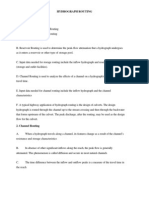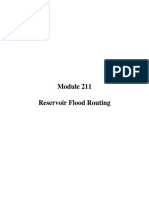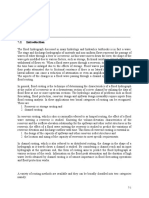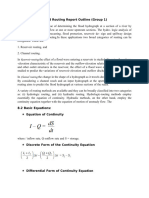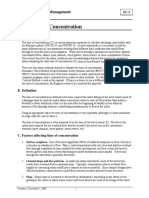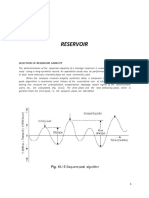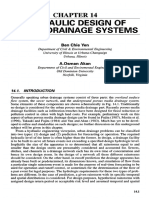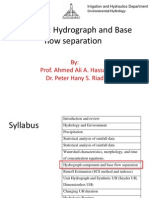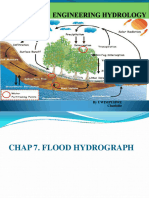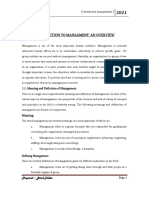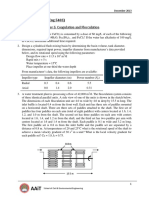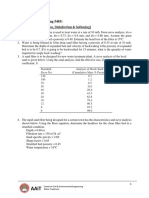Chapter 4-Flood Routing
Chapter 4-Flood Routing
Uploaded by
አድሜ ልስልሱCopyright:
Available Formats
Chapter 4-Flood Routing
Chapter 4-Flood Routing
Uploaded by
አድሜ ልስልሱOriginal Title
Copyright
Available Formats
Share this document
Did you find this document useful?
Is this content inappropriate?
Copyright:
Available Formats
Chapter 4-Flood Routing
Chapter 4-Flood Routing
Uploaded by
አድሜ ልስልሱCopyright:
Available Formats
Engineering Hydrology Lecture Note
TABLE OF CONTENTS
4 Flood Routing....................................................................................................................2
4.1 General.......................................................................................................................2
4.2 Simple Non-storage Routing.....................................................................................3
4.3 Storage Routing.........................................................................................................4
4.4 Reservoir or level pool routing..................................................................................5
4.5 Channel routing.........................................................................................................7
4.5.1 Muskingum Method of Routing........................................................................8
4.5.2 Application of the Muskingum Method:...........................................................9
Hydraulic & Water Resources Engineering Department, AMIT, AMU
1
Engineering Hydrology Lecture Note
4 Flood Routing
4.1 General
At a river gauging station, the stage and discharge hydrographs represent the passage
of waves of river depth and stream flow during flood, respectively. As this wave moves
down the river, the shape of the wave gets modified due to various factors, such as
channel storage, resistance, lateral addition or withdrawal of flows etc. when a flood
wave passes through a reservoir, its peak is attenuated and the time base is enlarged
(translated) due to the effect of storage. Flood waves passing down a river have their
peaks attenuated due to friction if there is no lateral inflow. In both reservoir and channel
conditions the time to peak is delayed, and hence the peak discharge is translated.
Flood routing is the technique of determining the flood hydrograph at a section of a river
by utilizing the data of flood flow at one or more upstream sections. The hydrologic
analysis of problems such as flood forecasting, flood protection, reservoir and spillway
design invariably include flood routing. In these applications two broad categories of
routing can be recognized. These are:
i) Reservoir routing and
ii) Channel routing
In reservoir routing the effect of a flood wave entering a reservoir is studied. Knowing
the volume-elevation characteristics of the reservoir and the out flow elevation
relationship for spillways and other outlet structures in the reservoir; the effect of a flood
wave entering the reservoir is studied to predict the variation of reservoir elevation and
out flow discharge with time. This form of routing is essential (i) in the design of the
capacity of spillways and other reservoir outlet structures and (ii) in the location and
sizing of the capacity of reservoirs to meet specific requirements.
In channel routing the changes in the shape of a hydrograph as it travels down a
channel is studied. By considering a channel reach and an input hydrograph at the
upstream end, this form of routing aims to predict the flood hydrograph at a various
sections of the reach. Information on the flood-peak attenuation and the duration of high-
water levels obtained by channel routing is utmost importance in flood forecasting
operations and flood protection works.
A variety of flood routing methods are available and they can be broadly classified in to
two categories as: (i) hydraulic routing and (ii) hydrologic routing. Hydrologic routing
methods employ essentially the equation of continuity and a storage function, indicated
as lumped routing. Hydraulic methods, on the other hand, employ the continuity
equation together with the equation of motion of unsteady flow. The basic differential
equations used in the hydraulic routing, known as St. Venant equations afford a better
description of unsteady flow than hydrologic methods.
A flood hydrograph is modified in two ways as the storm water flows downstream.
Firstly, and obviously, the time of the peak rate of flow occurs later at downstream
points. This is known as translation. Secondly, the magnitude of the peak rate of flow is
diminished at downstream points, the shape of the hydrograph flattens out, and the
Hydraulic & Water Resources Engineering Department, AMIT, AMU
2
Engineering Hydrology Lecture Note
volume at the floodwater takes longer to pass a lower section. This modification of the
hydrograph is called attenuation.
Figure 4.1: Flood translation and attenuation
4.2 Simple Non-storage Routing
Relationship between flood events and stages at upstream and downstream points in a
single river reach can be established by correlating known floods and stages at certain
conditions. The information could be obtained from flood marks on river banks and
bridge sides. Measurements/estimates of floods can then be related to known the level
of the flood at the upstream and downstream locations. With such curves it is possible to
give satisfactory forecasts of the downstream peak stage from an upstream peak stage
measurement.
Figure 4.2: Peak stage relationship
Hydraulic & Water Resources Engineering Department, AMIT, AMU
3
Engineering Hydrology Lecture Note
The time of travel of the hydrograph crest (peak flow) also need to be determined to
know the complete trace of modification of the wave. Curves of upstream stage plotted
against time travel to the required downstream point can be compiled from the
experience of several flood events.
Figure 4.3: Flood peak travel time
The complexities of rainfall-runoff relationships are such that these simple methods
allow only for average conditions. Flood events can have very many different causes
that produce flood hydrographs of different shapes. The principal advantages of these
simple methods are that they can be developed for stations with only stage
measurements and no rating curve, and they are quick and easy to apply especially for
warning of impending flood inundations when the required answers are immediately
given in stage heights.
4.3 Storage Routing
When a storm event occurs, an increased amount of water flows down the river and in
any one short reach of the channel there is a greater volume of water than usual
contained in temporary storage. If at the beginning of the reach the flood hydrograph is
(above normal flow) is given as I, the inflow, then during the period of the flood, T1, the
channel reach has received the flood volume given by the area under the inflow
hydrograph. Similarly, at the lower end of the reach, with an outflow hydrograph O, the
flood is given by the area under the curve. In a flood situation relative quantities may be
such that lateral and tributary inflows can be neglected, and thus by the principle of
continuity, the volume of inflow equals the volume of outflow, i.e. the flood
Hydraulic & Water Resources Engineering Department, AMIT, AMU
4
Engineering Hydrology Lecture Note
The principle of hydrologic flood routings (both reservoir and channel) uses the
continuity equation in the form of “Inflow minus outflow equals rate of change of
storage”.
(3.1)
Where:
It = Inflow in to the reach
Ot= Outflow from the reach
dS/dt =Rate of change of storage within the reach.
Alternatively, the continuity (storage) equation can be stated as in a small time
interval Δt the difference between the total inflow volume and total outflow
volume in a reach is equal to the change in storage in that reach, i.e.,
(3.2)
(3.3)
The time interval Δt should be sufficiently short so that the inflow and out flow
hydrographs can be assumed to be straight line in that interval. As a rule of thumb Δt ≤
1/6 of the time to peak of the inflow hydrograph is required.
The continuity equation (I-Q = dS/dt), forms basis for all the storage routing methods.
The routing problem consists of finding Q as a function of time, given I as a function of
time, and having information or making assumptions about storage, S.
4.4 Reservoir or level pool routing
A flood wave I(t) enters a reservoir provided with an outlet such as a spillway. The
outflow is a function of the reservoir elevation only, i.e., O = O (h). The storage in the
reservoir is a function of the flow reservoir elevation, S = S(h). Further, the water level in
the reservoir changes with time, h = h(t) and hence the storage and discharge change
with time. It is required to find the variation of S, h and O with time, i.e., find S=S (t), O =
O (t) and h = h (t), given I =I (t)
Hydraulic & Water Resources Engineering Department, AMIT, AMU
5
Engineering Hydrology Lecture Note
Figure 4.4: Storage routing (schematic)
Depending on the forms of the outlet relations for O (h) will be available. For reservoir
routing, the following data have to be known:
1. Storage volume versus elevation for the reservoir
2. Water surface elevation versus out flow and hence storage versus outflow
discharge
3. Inflow hydrograph, I= I(t); and
4. Initial values of S, I and O at time t = 0
The finite difference form of the continuity equation (Equation. 3.4) can be rewritten as:
(3.4)
Where, (I1+I2)/2= I ; (O1+ O2)/2 = O and S2-S1=ΔS and suffixes 1 and 2 to denote the
beginning and end of the time interval Δt Rearranging Equation (3.4) to get the
unknowns S2 and O2 on one side of the equation and to adjust the O 1 term to produce:
(3.5)
Since S is a function of O, [(S/Δt) + (O/2)] is also a specific function of O (for a given Δt).
Replacing {(S/Δt) + (O/2)} by G, for simplification, equation (3.5) can be written:
G2 = G1 + Im –O1 or more generally
Gi+1 = Gi + Im,i – Oi (3.6)
Where:
Im = (I1 + I2)/2
To apply this method we need beside I t also the G-O relation. The latter is easily
established from S-H and O-H relations, where for equal values of H, S and O are
determined; after which the proper interval Δt the G-O relation is established. Note that
G is dependent on the chosen routing interval Δt. The routing period, Δt, has to be
chosen small enough such that the assumption of a linear change of flow rates, I and O,
during Δt is acceptable (as a guide, Δt should be less than 1/6 of the time of rise of the
inflow hydrograph). So, in short, the method consists of three steps:
1. Inspect the inflow hydrograph and select the routing interval: Δt ≤ 1/6 time to
peak
2. Establish the G-O relation
Hydraulic & Water Resources Engineering Department, AMIT, AMU
6
Engineering Hydrology Lecture Note
3. Carry out the routing according to equation (3.6)
A useful check on the validity of any level pool routing calculation is that the peak of the
outflow hydrograph should occur at the intersection of the inflow and out flow
hydrograph on the same plot. At that point, I = O, so ds/dt = 0, i.e. storage is a maximum
and therefore O is a maximum. Therefore, the temporary storage is depleted.
Figure 4.5: Storage routing
Table 4.1: Tabular computation of level pool routing
4.5 Channel routing
In reservoir routing presented in the previous section, the storage was a unique function
of the outflow discharge, S=f(O). However in channel routing the storage is a function of
both outflow and inflow discharges and hence a different routing method is needed. The
flow in a river during a flood belongs to the category of gradually varied unsteady flow.
For a river reach where the water surface cannot be assumed horizontal to the river
bottom during the passage of a flood wave, the storage in the reach may be split up in
two parts: (i) prism storage and (ii) wedge storage
Prism Storage is the volume that would exist if uniform flow occurred at the
downstream depth, i.e. the volume formed by an imaginary plane parallel to the channel
bottom drawn at a direct function of the stage at the downstream end of the reach. The
surface is taken parallel to the river bottom ignoring the variation in the surface in the
reach relative to the bottom. Both this storage and the outflow can be described as a
single function of the downstream water level and the storage is a single function of the
out flow alone.
Hydraulic & Water Resources Engineering Department, AMIT, AMU
7
Engineering Hydrology Lecture Note
Wedge Storage is the wedge-like volume formed b/n the actual water surface profile
and the top surface of the prism storage. It exists because the inflow, I, differs from O
(out flow) and so may be assumed to be a function of the difference between inflow and
outflow, (I-O).
Figure 4.6: Determining storage in a river reach
At a fixed depth at a downstream section of river reach, prism storage is constant while
the wedge storage changes from a positive value at the advancing flood wave to a
negative value during a receding flood. The total storage in the channel reach can be
generally represented by:
S = f1(O)+f2(I-O) (4.7)
And this can then be expressed as:
S = K (x Im + (1-x)Om) (4.8)
Where K and x are coefficients and m is a constant exponent. It has been found that the
value of m varies from 0.6 for rectangular channels to value of about 1.0 for natural
channels.
4.5.1 Muskingum Method of Routing
Using m =1 for natural channels, equation (2.8), reduces to a linear relationship for S in
terms of I and Q as
S= K (x I+ (1-x)O (4.9)
This relationship is known as the Muskingum Equation. In this the parameter x is
known as weighing factor and take a value between 0 and 0.5. When x=0, obviously the
storage is a function of discharge only and equation (4.9) reduces to:
S = KQ (4.10)
Hydraulic & Water Resources Engineering Department, AMIT, AMU
8
Engineering Hydrology Lecture Note
Such storage is known as linear storage or linear reservoir. When x= 0.5 both the
inflow and out flow are equally important in determining the storage.
The coefficient K is known as storage-time constant and has dimensions of time. K is
approximately equal to the time of travel of a flood wave through the channel reach.
As before, writing the continuity equation in finite difference form, we can write
S2 - S1 = {(I1+I2)Δt}/2 - {(O1+O2) Δt}/2 (4.11)
For a given channel reach by selecting a routing interval Δt and using the Muskingum
equation, the change in storage can be determined.
S1 = K(xI1 + (1-x) O1) (4.12)
S2 = K(xI2 + (1-x) O2) (4.13)
Substituting equations (4.12) and (4.13) in equation (4.11) and after rearrangements
gives:
(4.14)
Note that ΣC=1 and thus when C 1 and C2 have been found C3=1-C1-C2. Thus the outflow
at the end of a time step is the weighted sum of the starting inflow and outflow and the
ending inflow. It has been found that best results will be obtained when routing interval
should be so chosen that K>Δt>2kx. If Δt < 2kx, the coefficient C2 will be negative.
4.5.2 Application of the Muskingum Method:
In order to use equation (2.14) for O i+1, it is necessary to know K and x for calculating
the coefficients, C. Using recorded hydrographs of a flood at the beginning and end of
the river reach, trial values of x are taken, and for each trial the weighted flows in the
reach, [xI+(1-x)O], are plotted against the actual storages determined from the inflow
and out flow hydrographs as indicated in the following figure.
Hydraulic & Water Resources Engineering Department, AMIT, AMU
9
Engineering Hydrology Lecture Note
Figure 4.7: Trial plots for Muskingum X values
When the looping plots of the weighted discharge against storages have been narrowed
down so that the values for the rising stage and the falling stage for a particular value of
x merge together to form the best approximation to a straight line, then that x value is
used, and the slope of the straight line gives the required value of K. for natural
channels, the best plot is often curved, making a straight line slope difficult to estimate.
Hydraulic & Water Resources Engineering Department, AMIT, AMU
10
You might also like
- Ethyl BenzeneDocument14 pagesEthyl Benzenectqmqyo0% (1)
- Marine Science - Teachers' GuideDocument234 pagesMarine Science - Teachers' GuideMLSBU11No ratings yet
- Characterization of Pore Pressure Conditions in Upstream Tailings Dams. MartinDocument12 pagesCharacterization of Pore Pressure Conditions in Upstream Tailings Dams. MartinandreaNo ratings yet
- Chapter 4-Flood RoutingDocument9 pagesChapter 4-Flood Routingyeshi janexoNo ratings yet
- Chapter 8 Flood RoutingDocument10 pagesChapter 8 Flood Routingnimcan50% (2)
- Chapter Four Flood Routing 4.1 General: Engineering Hydrology Lecture NoteDocument14 pagesChapter Four Flood Routing 4.1 General: Engineering Hydrology Lecture NoteKefene GurmessaNo ratings yet
- Flood Routing. PPT - 1Document29 pagesFlood Routing. PPT - 1Epa PaulNo ratings yet
- Lec 28-30Document24 pagesLec 28-30Minn Thu NaingNo ratings yet
- Hydrology Note 5Document28 pagesHydrology Note 5Zazliana IzattiNo ratings yet
- Hydrograph RoutingDocument18 pagesHydrograph RoutingRadu RozNo ratings yet
- Analysis of Flood Routing: February 2015Document6 pagesAnalysis of Flood Routing: February 2015Sarah KamilNo ratings yet
- Flood-Routing-Complete CH#8Document57 pagesFlood-Routing-Complete CH#8Sohail Sakhani100% (3)
- FloodroutingwreDocument15 pagesFloodroutingwreUJJWALNo ratings yet
- Flood Routing ReportDocument3 pagesFlood Routing Reportnjuc07f100% (1)
- Cvs 348: Engineering HydrologyDocument11 pagesCvs 348: Engineering Hydrologysalt2009No ratings yet
- Stelprdb1083097 PDFDocument40 pagesStelprdb1083097 PDFHidayat FatahNo ratings yet
- Flood RoutingDocument17 pagesFlood RoutingWaleed AlkhafajiNo ratings yet
- Flow Routing CEN 204 - March 2022Document20 pagesFlow Routing CEN 204 - March 2022Ayush KishoreNo ratings yet
- Chapter 7 - RoutingDocument23 pagesChapter 7 - Routingyudha_hermawan_kinoyNo ratings yet
- Importance of Hydraulic Factors in Bridge DesignDocument9 pagesImportance of Hydraulic Factors in Bridge DesignStevan StrangeNo ratings yet
- Reporting PointsDocument7 pagesReporting PointsnatilagacmaenelaNo ratings yet
- Flood Routing - 1Document36 pagesFlood Routing - 1SAURABH GUPTANo ratings yet
- LNS Hydraulic L1-V4Document186 pagesLNS Hydraulic L1-V4cm21lpm1No ratings yet
- Chapter Five: Flood RoutingDocument46 pagesChapter Five: Flood RoutingErmias EmiruNo ratings yet
- Disaster Management Plan: WAPCOS LimitedDocument11 pagesDisaster Management Plan: WAPCOS LimitedMallinatha PNNo ratings yet
- 5 Floods+EstimationDocument4 pages5 Floods+EstimationEhab AlganadyNo ratings yet
- Hydro TemplateDocument13 pagesHydro TemplateGwyneth SantosNo ratings yet
- CE 212 - Hydrology I - L8Document21 pagesCE 212 - Hydrology I - L8Adna RamićNo ratings yet
- Module 2-Hydrology and Irrigation EngineeringDocument7 pagesModule 2-Hydrology and Irrigation EngineeringDhanendra TMGNo ratings yet
- Time of Concentration (NRCS)Document16 pagesTime of Concentration (NRCS)Muhammad NaufalNo ratings yet
- HydrologyDocument35 pagesHydrologylordiorNo ratings yet
- Watershed CharacteristicsDocument5 pagesWatershed CharacteristicskristianvieiraNo ratings yet
- Central Luzon State University: Module 4: Page 1 of 40Document40 pagesCentral Luzon State University: Module 4: Page 1 of 40LENARD DE LEON100% (1)
- Ce44 Applied HydraulicsDocument84 pagesCe44 Applied HydraulicsMouna GuruNo ratings yet
- Reservoir RoutingDocument15 pagesReservoir RoutingMomostafaNo ratings yet
- GroundwaterDocument94 pagesGroundwaterAnthony MulengaNo ratings yet
- Flood Routing LectureDocument7 pagesFlood Routing Lectureامين الزريقي100% (1)
- Routing in A Simple ReservoirDocument6 pagesRouting in A Simple ReservoirEroll Morga VillanuevaNo ratings yet
- Chapter 6-ReservoirsDocument6 pagesChapter 6-ReservoirshadushNo ratings yet
- Dam DesignDocument48 pagesDam DesignPride MatengaNo ratings yet
- Hapter: ReservoirDocument10 pagesHapter: ReservoirKathiriya HardikNo ratings yet
- Reservoir Flood Routing2Document58 pagesReservoir Flood Routing2TibesoNo ratings yet
- Frequency AnalysisDocument29 pagesFrequency Analysisheyru abdoNo ratings yet
- 14 - Hydraulic Design of Urban Drainage Systems PDFDocument45 pages14 - Hydraulic Design of Urban Drainage Systems PDFDeprizon SyamsunurNo ratings yet
- Hydrology (1114)Document16 pagesHydrology (1114)tumma rambabuNo ratings yet
- Flood - RoutingDocument8 pagesFlood - RoutingLuna KimNo ratings yet
- Lecture 7 - Hydrograph and Base Flow Separation-3 PDFDocument36 pagesLecture 7 - Hydrograph and Base Flow Separation-3 PDFCiTaa AdiNo ratings yet
- Flood Propagation of The Blue Nile in The Sudan Using Muskingum RoutingDocument12 pagesFlood Propagation of The Blue Nile in The Sudan Using Muskingum RoutingCatalin_FusaNo ratings yet
- Dam Failure Part 2Document83 pagesDam Failure Part 2박래건No ratings yet
- Flood RoutingDocument17 pagesFlood RoutingGikonyoNo ratings yet
- Hydrology Finals ReviewerDocument5 pagesHydrology Finals ReviewerIra MejiaNo ratings yet
- Flood RoutingDocument8 pagesFlood RoutingLuna KimNo ratings yet
- Chapter 4 Rainfall Runoff ModellingDocument43 pagesChapter 4 Rainfall Runoff ModellingNur Farhana Ahmad FuadNo ratings yet
- Chap 7&8Document59 pagesChap 7&8ingenzihubertNo ratings yet
- Navigation & Voyage Planning Companions: Navigation, Nautical Calculation & Passage Planning CompanionsFrom EverandNavigation & Voyage Planning Companions: Navigation, Nautical Calculation & Passage Planning CompanionsNo ratings yet
- Terrestrial Water Cycle and Climate Change: Natural and Human-Induced ImpactsFrom EverandTerrestrial Water Cycle and Climate Change: Natural and Human-Induced ImpactsQiuhong TangNo ratings yet
- CHAPETR 1 Introduction To ManagementDocument7 pagesCHAPETR 1 Introduction To Managementአድሜ ልስልሱNo ratings yet
- Chapter 2Document12 pagesChapter 2አድሜ ልስልሱNo ratings yet
- Assignment For Sedimentation: Water Treatment (Ceng 5403)Document2 pagesAssignment For Sedimentation: Water Treatment (Ceng 5403)አድሜ ልስልሱNo ratings yet
- WT ch1Document20 pagesWT ch1አድሜ ልስልሱNo ratings yet
- A - B - C - D - E.: Construction Management - Section 1Document17 pagesA - B - C - D - E.: Construction Management - Section 1አድሜ ልስልሱNo ratings yet
- Assignment 1: Water Treatment (Ceng 5403)Document1 pageAssignment 1: Water Treatment (Ceng 5403)አድሜ ልስልሱNo ratings yet
- Assignment For Chapter 5: Coagulation and Flocculation: Water Treatment (Ceng 5403)Document2 pagesAssignment For Chapter 5: Coagulation and Flocculation: Water Treatment (Ceng 5403)አድሜ ልስልሱNo ratings yet
- Analysis of Long Span Roof TrussDocument6 pagesAnalysis of Long Span Roof Trussአድሜ ልስልሱNo ratings yet
- Gis (Geographic Information System)Document27 pagesGis (Geographic Information System)አድሜ ልስልሱ100% (1)
- Assignment Solution-3Document23 pagesAssignment Solution-3አድሜ ልስልሱNo ratings yet
- Assignment 3 & 4 - AnswersDocument23 pagesAssignment 3 & 4 - Answersአድሜ ልስልሱ100% (2)
- Structural Design of G 6 Urban BuildingDocument135 pagesStructural Design of G 6 Urban Buildingአድሜ ልስልሱNo ratings yet
- Assignment 4 (Filtration, Disinfection & Softening) : Water Treatment (Ceng 5403)Document3 pagesAssignment 4 (Filtration, Disinfection & Softening) : Water Treatment (Ceng 5403)አድሜ ልስልሱNo ratings yet
- How To Change The Default System Font On Windows 10Document13 pagesHow To Change The Default System Font On Windows 10አድሜ ልስልሱNo ratings yet
- Chap 03 FoundationDocument47 pagesChap 03 Foundationአድሜ ልስልሱNo ratings yet
- Chapter One Elements of Dam Engineering 2021Document17 pagesChapter One Elements of Dam Engineering 2021አድሜ ልስልሱNo ratings yet
- Basic TerminologiesDocument6 pagesBasic Terminologiesአድሜ ልስልሱNo ratings yet
- Highway I Lecture Not PDFDocument281 pagesHighway I Lecture Not PDFአድሜ ልስልሱNo ratings yet
- Basic Definitions Presumptive Bearing CapacityDocument57 pagesBasic Definitions Presumptive Bearing Capacityአድሜ ልስልሱNo ratings yet
- Bearing CapacityDocument16 pagesBearing Capacityአድሜ ልስልሱNo ratings yet
- Chapter 7-Basic Concepts of Stochastics HydrologyDocument18 pagesChapter 7-Basic Concepts of Stochastics Hydrologyአድሜ ልስልሱ100% (1)
- Chapter 3. Characteristics of Road and Road Users: Driver Pedestrian Bicycle Vehicle PropertiesDocument34 pagesChapter 3. Characteristics of Road and Road Users: Driver Pedestrian Bicycle Vehicle Propertiesአድሜ ልስልሱNo ratings yet
- Chapter 5-Hydrology of Ungauged CatchmentsDocument18 pagesChapter 5-Hydrology of Ungauged Catchmentsአድሜ ልስልሱNo ratings yet
- Examples For Chapter 2Document3 pagesExamples For Chapter 2አድሜ ልስልሱ100% (1)
- 06 Svetla STANKOVADocument9 pages06 Svetla STANKOVAAlejandro VelezNo ratings yet
- Datasheet PLT15Document8 pagesDatasheet PLT15ouss oussNo ratings yet
- Geography PakStd Memorization ListDocument68 pagesGeography PakStd Memorization ListSabeeha MansoorNo ratings yet
- Idea Proposal 121Document2 pagesIdea Proposal 121Vic SeungNo ratings yet
- A DETAILED LESSON PLAN FOR GRADE VII 4as - GarzonDocument8 pagesA DETAILED LESSON PLAN FOR GRADE VII 4as - GarzonKresha LluismaNo ratings yet
- DRR Paper 0107Document16 pagesDRR Paper 0107afreen.jbracNo ratings yet
- Tangki Septik Dan Peresapannya Sebagai Sistem Pembuangan Air Kotor Di Permukiman Rumah Tinggal KeluargaDocument9 pagesTangki Septik Dan Peresapannya Sebagai Sistem Pembuangan Air Kotor Di Permukiman Rumah Tinggal KeluargaGusnomo HendrawanNo ratings yet
- Boiler1 PDFDocument35 pagesBoiler1 PDFnbngoc012100% (1)
- WBSDocument4 pagesWBSShohel RanaNo ratings yet
- Maldives Bird GuideDocument52 pagesMaldives Bird Guideyaseenyoosuf5No ratings yet
- Sykes Pump BookletDocument105 pagesSykes Pump BooklethipsterzNo ratings yet
- Test Chapter 46 Major Ecosystems of The Biosphere QuizletDocument3 pagesTest Chapter 46 Major Ecosystems of The Biosphere Quizletapi-328608341No ratings yet
- Solid Waste PollutionDocument28 pagesSolid Waste Pollutionwinifred ekpoNo ratings yet
- TDS Chemflake Glass Flake SuggestedDocument5 pagesTDS Chemflake Glass Flake SuggestedShankar Pl GowdaNo ratings yet
- Applied Geochemistry: Mouigni Baraka Nafouanti, Junxia Li, Nasiru Abba Mustapha, Placide Uwamungu, Dalal AL-AlimiDocument8 pagesApplied Geochemistry: Mouigni Baraka Nafouanti, Junxia Li, Nasiru Abba Mustapha, Placide Uwamungu, Dalal AL-Alimik.ayushearth28No ratings yet
- VALVECAREDocument5 pagesVALVECAREaaronNo ratings yet
- Environmental Protection NWP 4-11: Naval Warfare PublicationDocument60 pagesEnvironmental Protection NWP 4-11: Naval Warfare Publicationsergiobicho1960No ratings yet
- The Applications of Heat Exchangers Refrigeration SystemsDocument38 pagesThe Applications of Heat Exchangers Refrigeration SystemsBasem RajabNo ratings yet
- Drinking Water Advice Note 15 WEB PDFDocument28 pagesDrinking Water Advice Note 15 WEB PDFMohammadSamadiNo ratings yet
- Floods and DroughtsDocument37 pagesFloods and DroughtsVernon90% (10)
- IADC Guidance For UBO and MPD Techniques Land Operations 06 29 21 v3Document17 pagesIADC Guidance For UBO and MPD Techniques Land Operations 06 29 21 v3hajiyevnatikNo ratings yet
- Air Quality and Livestock FarmingDocument413 pagesAir Quality and Livestock FarmingSofi Albertini Weiler0% (1)
- Design and Implementation of Well TestingDocument33 pagesDesign and Implementation of Well TestingMuhammad Tahir100% (1)
- Technical Specification El Adm 137 12Document50 pagesTechnical Specification El Adm 137 12palgvenuNo ratings yet
- An Oceanic Model For Lithological and Faunal Changes Tested On The Silurian RecordDocument12 pagesAn Oceanic Model For Lithological and Faunal Changes Tested On The Silurian RecordBiologia 2016No ratings yet
- Selection of Site For Quarrying of StonesDocument3 pagesSelection of Site For Quarrying of StonesRudrakshiNo ratings yet
- EcologyMCQs QuestionsDocument20 pagesEcologyMCQs QuestionsUpendra RaoNo ratings yet









